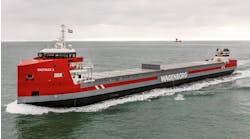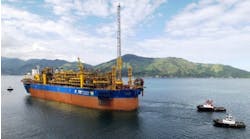Marathon strikes oil
Marathon Oil Corp. hit pay with Droshky No. 1 in Green Canyon block 244 in 2,900 ft (884 m) of water. The discovery well, drilled 137 mi (220 km) south-southwest of Venice, Louisiana, logged 250 ft (76 m) of net oil pay, according to Marathon.
“The preliminary results suggest that the Droshky No. 1 is a commercial discovery with development likely through the Troika Unit infrastructure, which is 2 mi (3 km) from the Droshky well,” says Philip G. Behrman, Marathon senior vice president of Worldwide Exploration.
Troika is a subsea field in Green Canyon block 244 in 2,700 ft (823 m) of water. The field produces through the Shell-operated Bullwinkle platform.
At print, Marathon was drilling two sidetracks on Droshky to determine the field’s commercial extent.
Marathon holds a 100 % working interest in Droshky No. 1 and a 50 % interest in the Troika Unit.
Application filed for LNG port off Florida
Höegh LNG AS subsidiary Port Dolphin Energy Llc. has filed an application with the US Coast Guard for approval to build and operate an LNG port 28 mi (45 km) off the west coast of Florida.
The proposed project consists of two submerged turret unloading and mooring buoys to receive an average of up to 800 MMcf/d of natural gas from LNG shuttle and regasification vessels (SRVs), and a 42-mi (68-km) offshore pipeline to bring the natural gas from the proposed terminal to Port Manatee in Tampa Bay. The port will have a peak delivery capacity of 1.2 bcf/d.
Rendering of Höegh LNG’s Port Dolphin Energy LNG facility, proposed for installation off the west coast of Florida.
“This is an important milestone in Höegh LNG’s effort to continue the development of our SRV strategy, where we provide transport, regasification, and market access for our customers,” says Sveinung Støhle, president and CEO of Höegh LNG AS.
Höegh LNG has two SRVs on order with Samsung Heavy Industries for delivery in 2009 and 2010 to serve Suez LNG Trading’s Neptune deepwater port, a similar offshore LNG terminal slated for Massachusetts Bay, near Boston.
Deepwater contracts
BHP Billiton and Shell have awarded subsea contracts for the Shenzi and Princess deepwater developments. BHP issued the Shenzi contract to Saipem America Inc. The contracted workscope includes transportation and installation of subsea equipment: installation of three combined electro-hydraulic dynamic umbilicals; design, fabrication, and testing of rigid subsea jumpers and nine suction piles; and installation of 66 flying leads, three manifolds, and eight SCR spool pieces on theShenzi TLP.
Saipem will use a mix of construction vessels from its in-house fleet and outside contractors’ to complete the work between February and November 2008.
The company contracted Aker Marine Contractors Inc. to perform portions of the design and engineering work on Shenzi, including use of the DP-3BOA Sub C construction vessel.
The Shenzi field is in Green Canyon blocks 609, 610, 653, and 654 in 4,400 ft (1,341 m) of water, approximately 120 mi (193 km) offshore. Partners in the development include Hess Corp. and Repsol YPF.
Shell awarded the Princess contract to Technip. The contract covers project management, engineering, fabrication, and installation of flowlines and steel catenary risers, and installation of pipeline-end-terminations. Installation is scheduled for the fourth quarter of this year.
The Princess development comprises tieback of four subsea water injection wells to the Shell-operatedUrsa TLP moored in Mississippi Canyon block 854 in 3,780 ft (1,152 m) of water.
Technip in Houston will execute the contract; Technip in Mobile, Alabama, will assemble the pipe stalks, and pipelay vesselDeep Blue will deploy the pipelines in a reel lay form.
Shell-operated Princess is a sub-salt accumulation in Mississippi Canyon block 765 in 3,610 ft (1,100 m) of water.
Meanwhile, Aberdeen-based International Mooring Systems (IMS), part of the Craig Group, is supplying its H-link connectors to an unnamed operator in the Gulf of Mexico, under contracts worth more than £2 million ($4 million).
The 3-metric ton (3.3-ton) connectors allow lengths of chain and mooring line to be grouped together for anchoring floating production units and semisubmersible rigs in deepwater.
According to IMS, the H-Link connectors extend the life and integrity of mooring lines and chain by avoiding the use of other chain material as a binding and anchoring device, which could cause abrasion leading to deterioration reducing the life of the mooring line.
The connectors will be manufactured in the UK for scheduled installation in the GoM this year.
“These new contracts show exactly why we moved to invest in developing new technologies and equipment, as the industry looks to install the latest systems to ensure its assets and investments are protected in the GoM,” says Alan Duncan, IMS managing director.
Range sells shallow water properties
Range Resources Corp. has sold its GoM properties to a private company for $155 million.
The properties include Range’s interests in 37 platforms in water depths ranging from 11 to 240 ft (3 to 73 m). At year-end 2006, Range estimated the properties contained proved reserves of 40 bcfe.
“The properties were not integral to our future growth, so we elected to monetize them,” says John Pinkerton, Range president and CEO.
Caesar backlog filling up
Helix’s latest deepwater construction vessel,Caesar, will have plenty of work lined up when it enters the company’s active fleet in late-2007/early-2008. The $138-million vessel is undergoing conversion at COSCO shipyard in Shanghai.
The company has secured one external contract and one in-house commitment for the vessel in 2008. The outside job was awarded by Murphy E&P Co. The operator issued a letter of intent to Helix for installation work on the Thunder Hawk field in Mississippi Canyon block 736 in 6,100 ft (1,859 m) of water.
The contracted workscope includes installation of two 8-in. (203-mm) flowlines and two 12-in. (305-mm) export pipelines, with associated steel catenary risers and pipeline-end- terminations. The work is scheduled for mid-2008.
“The execution of the LOI for Thunder Hawk constitutes a major milestone forCaesar and our company,” says Bart Heijermans, Helix executive VP and COO. “We are very pleased with the level of interest in the vessel and are confident that this asset will become a major contributor to our company and the industry.”
Caesar also is scheduled to install the flowline for Helix’s Noonan discovery in Garden Banks block 506 in 2,700 ft (823 m) of water. Installation is scheduled for the first half of 2008.
Meanwhile, Helix’s deepwater reel lay vessel,Intrepid, completed installation of Shell Offshore Inc.’s Crosby Pastel Pink pipe-in-pipe (PIP) flowline system. This project was the company’s first PIP system that it constructed and installed, according to Helix.
The company’s workscope included construction and installation of the 4-in. (102-mm) x 8-in. (203-mm) PIP and pipeline-end-termination from Mississippi Canyon block 899 to MC 898 in 4,000 ft (1,219 m) of water. Installation was completed in mid-2007.
US Steel to acquire Lone Star Technologies
United States Steel Corp. will acquire Lone Star Technologies Inc. for $2.1 billion in cash.
US Steel says it expects the acquisition of Lone Star to strengthen its position as a producer of tubular products for the energy sector and will create North America’s largest tubular producer, with manufacturing capacity of 2.8 million tons (2.5 million metric tons).
“This transaction represents a compelling strategic opportunity for US Steel to strengthen our position as a supplier to the robust oil and natural gas sector by significantly expanding our tubular product offerings, our production capacity and our geographic footprint,” says John P. Surma, US Steel chairman and CEO.
“Our complementary strengths will better position Lone Star to pursue significant new growth opportunities for the benefit of our customers, distributors and end users,” says Rhys Best, Lone Star chairman and CEO.
Under the terms of the definitive agreement, US Steel will acquire all outstanding shares of Lone Star for $67.50 per share in cash - an aggregate value of approximately $2.1 billion.
The companies’ boards have approved the acquisition, but it still is subject to the approval of Lone Star’s shareholders and other customary closing conditions, including regulatory approvals. The transaction is expected to close in the second half of this year.
M/VFirst and Ten, a Rigdon 4000-class PSV design, was launched at Bollinger Shipyard’s Lockport, Louisiana facility on March 30. The diesel electric-driven vessel is the first of 10 being built at Bollinger for Ridgon. The DP-2 vessels are 190 ft (58 m) x 46 ft (14 m) x 18 ft (6 m), with 4,000 bbl of liquid mud and 5,500 cu ft (156 cu m) of bulk capacity.
null





